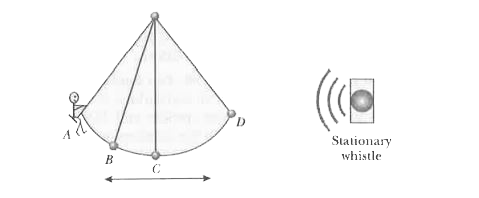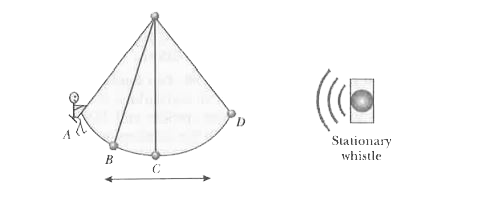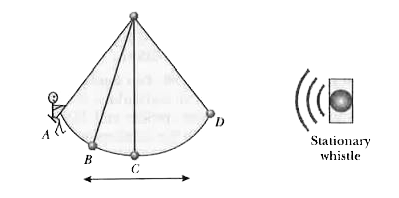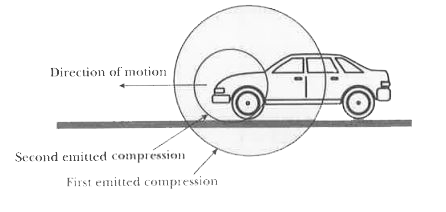The diagram shows the various positions of a child in motion on a swing. Somewhere in front of the child a stationary whistle is blowing.

At which position(s) will the child hear the same frequency as that heard by a stationary observer standing next to the whistle?
At both A and D.
At C when moving toward B
At B when moving toward A
At C when moving toward D
The correct Answer is:A
Step by step video, text & image solution for The diagram shows the various positions of a child in motion on a swing. Somewhere in front of the child a stationary whistle is blowing. At which position(s) will the child hear the same frequency as that heard by a stationary observer standing next to the whistle? by Physics experts to help you in doubts & scoring excellent marks in Class 12 exams.
Topper's Solved these Questions
- BOOK - RESNICK AND HALLIDAYCHAPTER - WAVE - IIEXERCISE - PRACTICE QUESTIONS (MATRIX MATCH)4videos
WAVE - II
- BOOK - RESNICK AND HALLIDAYCHAPTER - WAVE - IIEXERCISE - PRACTICE QUESTIONS (INTEGER TYPE)5videos
WAVE - II
- BOOK - RESNICK AND HALLIDAYCHAPTER - WAVE - IIEXERCISE - PRACTICE QUESTIONS (MORE THAN ONE CORRECT CHOICE TYPE)6videos
WAVE - II
- BOOK - RESNICK AND HALLIDAYCHAPTER - VECTORS EXERCISE - PRACTICE QUESTIONS39videos
VECTORS
- BOOK - RESNICK AND HALLIDAYCHAPTER - WAVES-IEXERCISE - Practice Questions (Integer Type)4videos
WAVES-I
Similar Questions
A child swinging on a swing in sitting position, stands up, then the time period of the swing will.
View SolutionAn engine is moving on a circular track with a constant speed. It is blowing a whistle of frequency 500Hz. The frequency received by an observer standing stationary at the centre of the track is
View Solution
Knowledge Check
- Question 1 - Select One
The diagram shows the various positions of a child in motion on a swing. Somewhere in front of the child a stationary whistle is blowing.

At which position(s) will the child hear the lowest frequency for the sound from the whistle?AAt both A and D.BAt C when moving toward BCAt B when moving toward ADAt C when moving toward D. - Question 2 - Select One
The diagram shows the various positions of a child in motion on a swing. Somewhere in front of the child a stationary whistle is blowing.

At which position(s) will the child hear the highest frequency for the sound from the whistle?AAt both A and D.BAt C when moving toward BCAt B when moving toward A.DAt C when moving toward D - Question 3 - Select One
The car in the figure is moving to the left at 35 m/s. The car's horn continuously emits a 2.20×102 Hz sound. The figure also shows the first two regions of compression of the emitted sound waves. The speed of sound is 343 m/s.

What is the frequency heard by a stationary observer standing in front of the car?A9.7 HzB245 HzC176 HzD219 Hz
A railroad train is travelling at 30ms in still air. The frequency of the note emitted by locomotive whistle is 500 Hz. Speed of sound is 345ms.
Q. What is the frequency of the sound waves heard by a stationary listener in front of the train?View SolutionA train is approaching towards a platform with a speed of 10ms−1, while blowing a whistle of frequency 340 Hz. What is the frequency of whistle heard by a stationary observer on the platform ?
(given, speed of sound =340ms−1)View SolutionA train in approaching a station with a uniform velocity of 72kmph and the frequency of the whistle of that train is 480Hz. The apparent increase in the frequency of that whistle heard by a stationary observer on the platform is (Velocity of sound in air is 340m/s)
View SolutionWhen a train approaches a stationary observer, the apparent frequency of the whistle is n' and when the same train recedes away from the observer, the apparent frequency is n. Then the apperent frquency n when the observer sitting in the train is :
View SolutionA train standing at the outer signal of a railway station blows a whistle of frequency 400 Hz in still air. The train begins to move with a speed of 30 ms−1 towards the platform. The frequency of the sound heard by an observer standing on the platform is
(Speed of sound in air = 330 m s−1)View Solution

